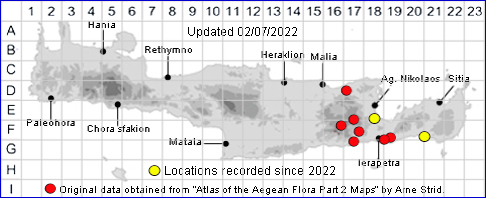
ONOPORDUM MAJORII
Family:- COMPOSITAE/Sect. PSEUDOCARLINA
Common Names:- None
Synonyms:- None
Meaning:- Onopordum (Gr) Ass-fart (its reputed flatulent effect on donkeys).
Majorii (L) The name honors Charles Immanuel Forsyth Major a Swiss
zoologist and vertebrate palaeontologist.
General description:-
Stem:-
1) Up to 150 cm. whitish-arachnoid-hairy; wings up to 8 mm wide, triangular-
acuminate, with 3- to 5-palmate spines, with apical spine up to 15 mm.
Leaves:-
1) Up to 45 x 15 cm, lanceolate, sessile, pinnatisect or almost pinnate, greyish-
green, sparsely hairy and glandular above, densely greyish-tomentulose beneath,
lobes triangular-acute, deeply lobulate, with apical spine up to 10 mm.
Flowers:-
1) Capitula 45-50 x 70-80 mm, hemispherical, glabrous.
2) Involucral bracts 5-8 mm wide at base:
a) outer and middle deflexed, with a wide fimbriate-spiny apex, the apical spine
up to 10 mm, caudate, the others spines 1-3 mm.
3) Corolla 35-50 mm, purple.
Fruit:-
1) Achenes 6-7 mm.
2) Pappus 9-14 mm.
Key features:-
1) Pappus not more than 15 mm.
2) Outer and middle involucral bracts expanded into a wide fimbriate-spiny apex.
3) Indumentum of the stem and leaves is more whitish than in Onopordum
bracteatum subsp. creticum.
Habitat:- Roadsides, dry grassland, open grassy communities, gravelly hillslopes.
0-600(-1150) m.
Distribution:- Endemic E.Crete, Karpathos E. Aegean Islands. Very rare on Crete,
known only from a few locations.
Flowering time:- Late Apr to early July.
Photos by:- Steve Lenton
Status:-
Protection status (for threatened species): Greek Presidential Decree 67/1981
Conservation status (for threatened species): Rare (R) according to IUCN 1997
Plant species with restricted geographical distribution.
SPECIES DESCRIPTION
